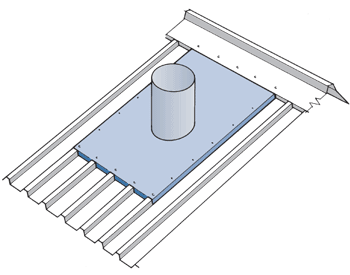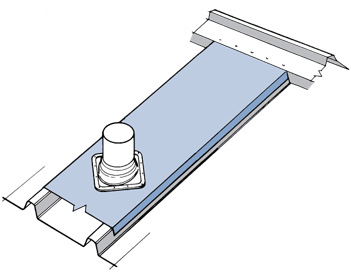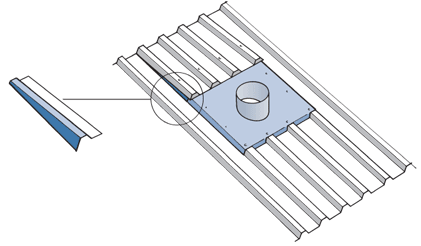Type B Watershed
Watershed flashings are not the preferred method of roof penetration flashing, and they are not aesthetically acceptable in many installations. They are an acceptable method of penetration flashing within the restrictions stated.
A 'watershed' or back flashing is used in the end span and is best restricted to within 1.5 m of the ridge so that it will not restrict roof movement, or cause expansion or condensation problems. If it is no wider than 1100 mm (1200 mm – 50 mm downturn at each edge) the back tray can be made in one piece, but a deeper or longer penetration is subject to a different design detail. It is not acceptable to seam or join flat sheet as a back flashing. See Watershed (a).
When a watershed flashing extending further down the roof than the first purlin is not acceptable, alternative designs using a Type A soaker, a Type C tapered flashing, or a sprung roof flashing should be used. See Type C Tapered.
If the width of the watershed flashing does not exceed 300 mm it has the length restriction as other flashings. See Roof Cladding Expansion Provisions.
The over-flashing should be made in maximum lengths of 6 m, using the same fixings and the same expansion provisions as the main roof cladding. (e.g. oversize holes). It is acceptable to use a boot flashing in conjunction with a watershed flashing without restriction on the pitch.
Watershed design is used where the penetration would obstruct the water flow in the pan, and is used for a retrofit or where the pipe cannot be shifted.
Washered screws should fasten the back flashing to the underneath roof cladding as rivets are not acceptable fasteners for this situation.
Another method of using a watershed type flashing can be achieved by a 'sprung' roof. Using this method the sheet is sprung by lifting the sheet from the existing fastening by the rib height.
For deeper ribs, this distance would be increased automatically because the purlin spacing is presumed to be greater. Additional support is required at the side lap of the sheeting. A tapered flashing is used at the sheet edges to provide the weathering as shown in Tapered Flashing and Sprung Roof.
- Log in to post comments




